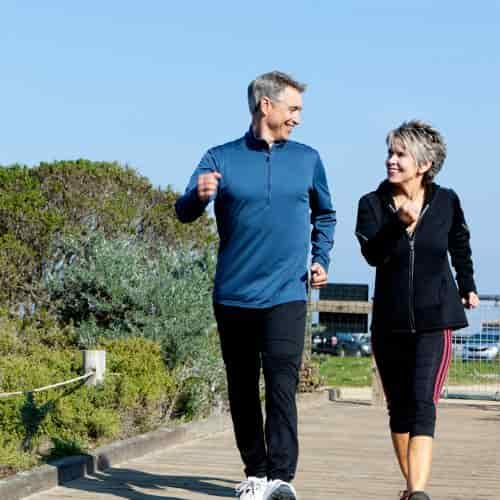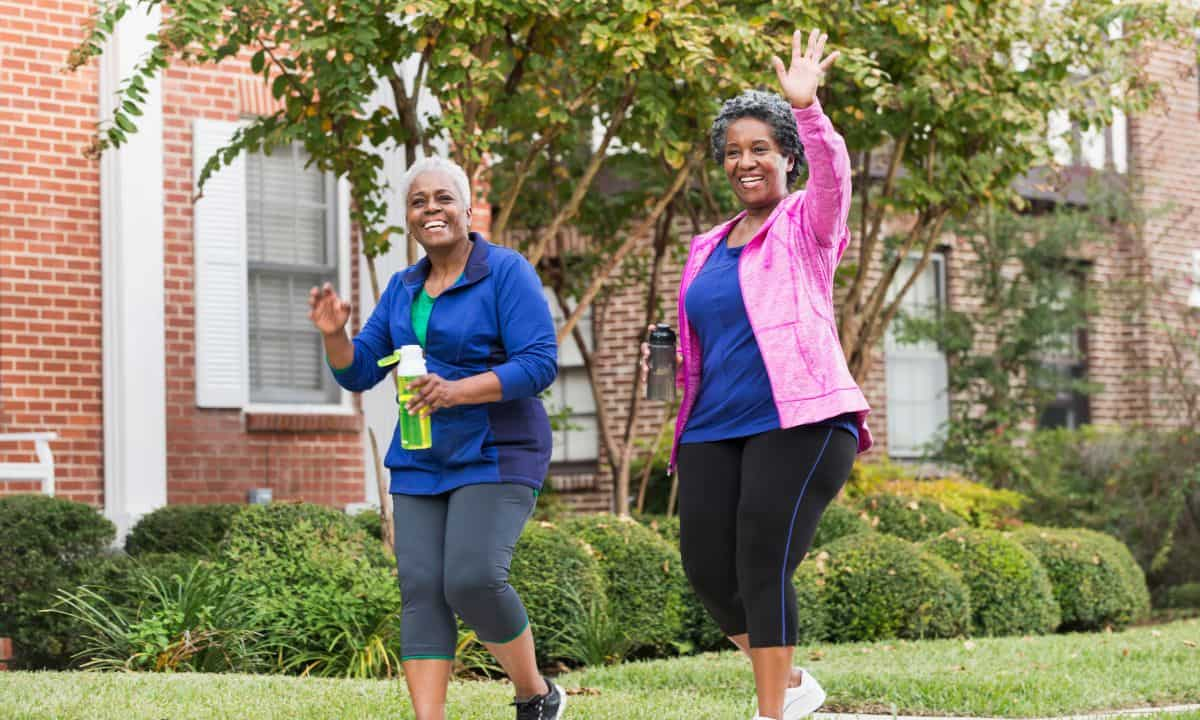Can You Lose Weight by Walking a Mile a Day?
The answer is yes! In fact, walking can help with weight loss in many ways. It is a low-impact exercise that can be done pretty much anywhere.
Table of Contents
TogglePlus, it’s FREE!
The benefits of walking for weight loss don’t stop with the calories you burn. It can also improve your mood and help to reduce stress levels. When you’re feeling good, you’re more likely to make healthier choices in other areas of your life, including in your eating habits.
So, if you’re looking for a simple way to start losing weight, begin by taking a one-mile walk a day and see what happens. Not only will it help with weight loss, but you will also feel better mentally and physically.
Give it a try and see for yourself!
Can You Lose Weight Walking?
Walking is a great way to lose weight and change your body composition.
A review of 96 studies that included 7,456 participants concluded that it can indeed help you achieve your weight loss goal.
For best results, experts recommend 150 minutes of exercise per week or a little above 21 minutes a day. So you can see how taking that one-mile walk every day can help you get very close to such a goal.
How Walking Can Help With Weight Management
Walking can help you manage your weight in many different ways. It’s a great way to burn calories, can help to boost your metabolism, improve your mood and even contribute to reducing stress levels.
And in case you didn’t know, lower stress can help tremendously to fight that stubborn belly fat.
But let’s look at the benefits in more detail.
Walking Burns Calories
Taking a walk sounds simple, but it’s a great way to get exercise and burn calories. The amount of calories you will burn depends on many factors such as your age, gender, weight, and how fast you walk.
The general rule of thumb is that you lose one pound for every 3,500 calories you burn.
But it’s not quite as simple as that. This type of exercise opens a chain of reactions that can lead to weight loss beyond just the calories burned during each walk.
The table below shows you how many calories you burn depending on your weight and the number of miles you cover. This table considers a moderate-intensity pace of 15 minutes per mile.
There are many phone apps and trackers to measure your speed and calories if you want to be more accurate.
| Weight/Miles (walking 15/min mile) | 1 mile (15 min) | 2 miles (30 min) | 3 miles (45 min) | 4 miles (60 min) |
| 125 lbs | 68 | 135 | 202 | 270 |
| 150 lbs | 81 | 162 | 243 | 324 |
| 175 lbs | 95 | 189 | 284 | 378 |
| 200 lbs | 108 | 216 | 324 | 432 |
| 250 lbs | 136 | 270 | 404 | 540 |
This table was created using the calorie burn rate calculator by the University of Rochester Medical Center.
Apps and Fitness Trackers
There are many ways to measure your progress. If you want to get fancy, you can buy a pedometer or fitness tracker. But many people just use their cell phones. There are plenty of apps to choose from that can track your steps, distance, and calories burnt.
Alternatively, you can also use a smartwatch to track your progress. A common goal while using these apps is to reach 10,000 steps.
Walking Can Help Change Body Composition
Going for a walk is a great way to get some exercise and fresh air, and it turns out that it can also help build some muscle.
When you walk, your muscles have to work against gravity to move your body forward. This resistance helps increase bone density and tone and build muscle.
Why is this important? Well, muscle burns more calories than fat, even when you’re not exercising. However, alternating this type of exercise with other forms of muscle-building activity is recommended for additional benefits.
Muscle-building exercises include power yoga, pilates, and weightlifting.
Walking Improves Your Mood

When it comes to lifting your mood, there’s no need to look further than your own two feet. Research shows that a simple stroll can profoundly impact your mental state, providing an instant and lasting boost of energy and happiness.
If you go out with others, the benefits are even more pronounced. Walking combined with positive interactions with others can improve negative moods, fight depression and improve self-esteem
Why is this important for weight loss? When you’re happy, taking good care of yourself is easier.
Additionally, depression can lead to changes in appetite, cravings for unhealthy foods, and a general lack of motivation to exercise. As a result, people who are depressed may find themselves gaining weight.
So gather your friends and set up a time to head out every week, or get your partner and just stroll around the block after dinner.
FAQs About Walking and Weight Loss
Can you lose weight by walking a mile every day?
Yes, It is possible to lose weight by covering a mile every day. However, what you eat is also important. Healthy eating, combined with exercise, will yield better results.
What can you do to see faster results? You can:
- Walk faster
- Walk longer
- Combine walking with other weight-bearing exercises such as power yoga, pilates, or weightlifting.
How much weight can you lose by walking a mile every day?
It depends on many factors, but a 150-pound woman can burn enough calories to lose 8-10 pounds a year.
Keep in mind that completing a mile may seem like a significant challenge if you’re just starting. But with time, you can complete a mile in 10 or 15 minutes. As you increase your speed, do it gradually to prevent injuries.
Can you lose weight walking 5 miles a day?
Walking 5 miles a day will help you achieve the recommended exercise guidelines for sustained weight loss. But it’s also important to eat healthy to reach your weight loss goals.
How fast do I need to walk to lose weight?
Moving briskly (15 minutes per mile) is considered a moderate-intensity exercise. To lose weight, the CDC recommends exercising for 150 minutes a week at moderate intensity in combination with a healthy diet.
Can Walking Help Reduce Belly Fat?
A small study among overweight women following a 12-week walking program showed a significant reduction in visceral fat. These women walked three days a week, averaging 50-70 minutes.
It’s also entirely possible to have the same effects by doing less but more often.
At least part of the reason walking is good for fighting belly fat is because it helps to reduce stress as well as promotes better sleep, both of which are important in reducing abdominal fat.
How Far is a Mile?
To put it in perspective:
If you’re going at a brisk pace, one mile will take you approximately 15 minutes to complete.
A mile is:
- 1.6 kilometers
- 17.5 football fields
- 4 laps around a typical indoor track
As we have already seen, it’s very easy to measure how far you are walking using a tracking device or a phone app.
How Fast do You Need to Walk?
The CDC recommends working your way up to 150 minutes of moderate-intensity aerobic activity, 75 minutes of vigorous activity, or a combination of both each week. The CDC also encourages eating healthy to achieve weight loss.
Moderate intensity means walking briskly (15-minute mile) or walking until you feel your heart rate elevated.
How to Incorporate Walking into Your Routine
If you’re new to any sort of physical activity, start slowly by walking for just 10 minutes a day. If that feels like too much, break it down into two five-minute walks. Once you’re comfortable with that, gradually start to increase your time and distance.
A good goal to aim for is 30 minutes most days of the week. Walking uninterrupted is great, but if you can’t fit in a 30-minute session, try three 10-minute walks instead.
To help make walking a part of your routine, here are a few tips:
- Schedule it into your day: Set aside time for a morning or after-dinner stroll. Or gather a group of co-workers and go out during your lunch break.
- Find a walking buddy: Invite a friend or family member to join you. It’s more fun — and motivating — than walking alone. Plus, you will probably be more likely to stick with it if someone’s counting on you to turn up.
- Make it enjoyable: Listen to music, a podcast, an audiobook, or call a friend while you’re out. Or try going to a different place every day to mix things up and explore your community.
- Get the right gear: Comfortable shoes are key. But if you walk often, it’s also worth investing in weather-appropriate clothing and accessories, such as a hat or sunglasses.
Do I Need Special Shoes?
If you’re only out for 15 minutes, you don’t need to worry about getting new shoes. But as you cover more territory, this is an important consideration.
A pair of supportive, comfortable shoes can make a big difference to your ability to go greater distances and prevent foot pain. So when you buy new shoes, go to the store and move around to see how you feel.
It’s also important to buy shoes half size to a full size bigger than you normally wear, as your feet tend to expand as you walk. This will prevent you from injuring your toes.
Specialized stores that cater to runners can help you with the selection by observing your movement on a treadmill and taking a few measurements. Here is a list of good walking shoes.
Do I Need Special Gear for Walking?
If you travel long distances, you will need special gear. Don’t use not having this gear as an excuse for not starting.
The only truly important item of equipment is a water bottle with you — any bottle!
These are the things that can make your exercise more pleasurable:
- Comfortable socks
- Dressing appropriately for the weather. If you’re in a colder climate, dress in layers so you can remove clothes as you warm up. If you’re in hot weather, dry-fit clothes work wonderfully.
- Water bottle
- Sunscreen, hats, and sunglasses
- Fitness tracker (optional)
Effects of Walking on Menopause Symptoms
Walking is a low-impact form of exercise with many benefits, including reducing menopause symptoms.
Some of the advantages of this type of exercise that are specifically beneficial for menopausal women include:
- Improving sleep quality
- Reducing stress and anxiety
- Reducing risk of heart disease
- Improving bone health
There are also a few studies that consider the positive impact of walking on hot flashes and night sweats.
Considering how easy it is to start walking and its many benefits, it’s definitely worth a try.
The Bottom Line
When it comes to your health, can you lose weight by walking a mile a day? The answer is yes! It is a great, low-impact way to get your body moving and start burning calories.
However, it does much more than just burning calories. It can help improve your mood and reduce stress, which can give you the spirit you need to take better care of yourself. Walking is great for your overall physical and mental health.
So, put on your comfortable shoes and hit the pavement!

Dr. Su-Nui Escobar, a Registered Dietitian/Nutritionist in Miami, FL, is dedicated to empowering women in perimenopause and menopause to live healthier, more satisfying lives.
With a doctorate in clinical nutrition from the University of North Florida, she has expertise in menopause and weight loss, including the unique challenges faced by those on weight loss medications.
Su-Nui’s passion for her field is evident in her previous role as the Academy of Nutrition and Dietetics spokesperson.


